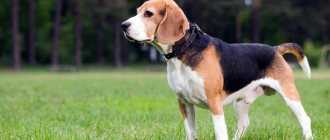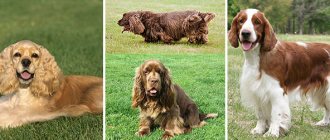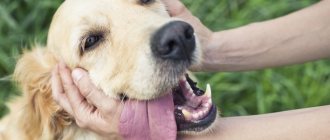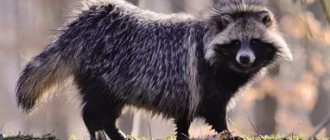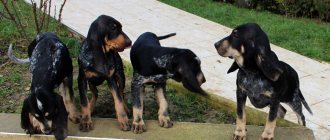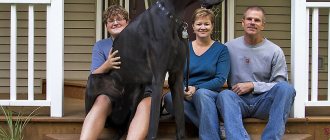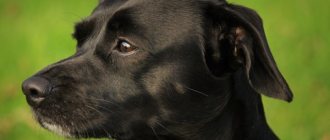Peruvian hairless dogs or Inca orchids are elegant, harmoniously built animals with a slender body covered in smooth, elastic skin. They belong to primitive varieties and began to form long before the birth of the Inca civilization.
Let's find out what Peruvian hairless dogs are and what features are hidden behind their extravagant appearance.
History of the origin of the breed
In Spanish, the breed is called perro sin pelo del Peru, but it also has a more poetic name “Peruvian Inca orchid”, although it was known and bred in some cultures long before the Incas. The earliest archaeological finds depicting her date back to the third century BC. Burials with skeletons of Peruvian hairless dogs are found in Peru to this day. The Incas considered the Peruvian moon dog sacred, endowed it with mystical healing powers, and used it in rituals.
From the beginning of the sixteenth to the nineteenth centuries, the “hairless” breed almost became extinct, as it interbred uncontrollably with “wool” individuals. The process stopped when the Peruvian authorities banned their export and uncontrolled reproduction, which they declared to be the property of the nation. The Peruvian Hairless received recognition from the American Kennel Club in 1996, and from the International Canine Federation in 1981.
Brief historical background
The creator and author of this unique breed is a fairly well-known Russian breeder and dog handler N.P. Nasibova. She began developing a new breed line relatively recently; the idea of getting a small, cute lap dog, best suited for apartment conditions, was born in 1993, and in 1997 the first animals appeared. Several miniature dog breeds were used in the selection work, the list of which the author does not disclose in order to avoid fakes. Over several years of painstaking work, we managed to breed a small pet with the desired breed characteristics.
At the end of 2007, the breed under the official and original name “Petersburg Orchid” was included in the register of State protected breeding achievements in the section of domestic dogs. A patent and copyright certificate were issued. Currently, Nina Nasibova is the head and leader of the special-breed dog club “Petersburg Orchid”, she solely controls the breeding of the breed (exercises author’s control), all documents for the livestock are issued by her personally, certified by signature and seal.
The St. Petersburg Orchid breed was developed by breeder Nina Nasibova
The breed is not yet considered completely established; it is constantly being improved and improved. Selection work on the creation of new mixed-blood lines continues tirelessly, otherwise the breed will not be able to breed within itself without an influx of someone else's fresh blood from the outside. None of the international cynological associations currently recognize St. Petersburg orchids; these dogs are known exclusively on the territory of our country.
Description of the breed
Graceful, harmoniously built, fast dogs. Spotted individuals from afar look like deer. Their skin has a texture similar to that of humans. They seem hot to the touch, but this is due to the difference between normal dog (37.5 - 39 degrees) and human temperatures. Based on their “clothing”, individuals are distinguished between those with and without fur.
Breed standard
Head:
- wide at the top, wolf-like in structure;
- forehead and muzzle are parallel;
- an incomplete set of teeth (associated with the hairlessness gene) or no teeth at all;
- “dressed” dogs have a full set;
- Small Peruvian hairless cats, as a rule, have fewer teeth than medium and large hairless ones;
- scissor bite of incisors;
- the nose is pigmented, straight, the color is in harmony with the color of the skin (coat);
- the eyes are medium-sized, almond-shaped, attentive, the color of the iris (from yellow to black) is in harmony with the color;
- the ears are medium, triangular, laid back or at an angle of 50 - 90 degrees to each other;
- neck without dewlap, flexible.
Torso:
- the ratio of height at the withers to the oblique length of the body is 1:1, bitches are slightly elongated in length;
- the back is straight, strong, a convexity in the lower back is acceptable;
- the croup is rounded, inclined;
- The chest is deep, but not wide, the ribs are slightly curved;
- the underline is elegant, the belly is tucked in;
- the tail is slightly curved, lowered or raised.
Legs:
- medium, “hare” type;
- front vertical, not turned elbows;
- posterior vertical with rounded muscles;
- The pads are heat-resistant, there are membranes between the toes, and the claws are longer than average.
Naked skin:
- smooth, elastic skin with several rounded lines on the skull;
- color from black to white, monochromatic is preferred, pink or white spots are acceptable (on no more than 1/3 of the body surface);
- remnants of hair on the head, paws and tail; their absence is preferable.
Wool of “dressed” ones:
- smooth, close-fitting, very short, sparse hair;
- curly, waviness is unacceptable;
- any color.
| Growth variety | Height, cm | Weight, kg |
| big | 51 — 65 | 12 — 22 |
| average | 41 — 50 | 8 — 12 |
| small | 25 — 40 | 4 — 8 |
Dossier
Height of an adult dog: miniature - 25-40 cm, medium - 40-50 cm, standard 50-65 cm. Weight: miniature - 4-8 kg, medium - 8-12 kg, standard - 11-22 kg. Characteristic color: black, dark blue, brown, graphite, light fawn, ivory. Hair length: no hair. Life expectancy: up to 14 years. Advantages of the breed: cheerful, active, makes an excellent companion, easy to train. Difficulties of the breed: jealous, loves to demonstrate its superiority over other animals. Requires special, constant care. Average price: $1,000. Classification: small, medium, large, hunting.
Character and behavioral characteristics
A balanced, alert guard and companion dog. He does not like to leave the house and the owner, to whom he becomes strongly attached; he may never get used to the new owner. He is jealous of his owner towards small dogs, respects large ones, and maintains polite neutrality with cats, but due to the instinct of a hunter, he can chase them. Doesn't trust strangers. “Wakes up” in the evening, prefers to stay awake at night.
A breed characteristic of the Peruvian Hairless is that it does not like to be touched by strangers.
Affenpinscher
And the appearance of this dog is not only original, but also quite frightening. It would seem that what’s scary about a round head with short fur, button eyes and an expressive mustache? But when the dog shows his teeth, he looks like a little devil!
The dog has a fighting character and is always ready to stand up for itself and its owner, despite its modest size. This especially applies to males; females are much softer and more flexible.
Don’t think that a small dog is decorative by default. On the contrary, the Affenpinscher has unsurpassed working qualities. This is evident from the strong muscular physique and lively movements.
Education and training
The Peruvian Hairless is an intelligent, quick-witted breed that is easy to raise and train, especially if you use rewards such as treats. She is very sensitive and does not tolerate harshness. It is better to ban something gently. For the same reason, socialize your orchid very gradually so that she does not lose confidence in herself. The best age to start training is 8 - 12 weeks. When you start training, consider your pet's natural sleep-wake cycle: train in the late afternoon. Short workouts are better than long ones.
Bullets
This breed is unusual not only for its appearance, but also for its habits. Puli is a shepherd dog, and to make it more convenient to watch the flock, it is taught to jump on the back of a sheep. The spectacle is interesting - despite the fact that the bullet with its shaggy dreadlocks almost merges with the sheep.
Today people also know this breed as an excellent hunting assistant. Such dogs are especially clever at pulling game that has fallen into it out of the water. Puli is very easy to train, the dog is intelligent and loyal.
The wool, which looks like cords and makes the animal’s appearance so unforgettable, performs important functions. This is protection from water, heating, and a means of camouflage from predators.
Diseases and care
The breed is healthy, but dogs have a hard time withstanding heat and frost, since the entire surface of the body is involved in thermoregulation (sweating), and not just the protruding tongue. To exist normally in the Russian climate, the Inca “orchid” always needs shade in the summer and warm clothes in the winter. The skin of the ears is especially thin and cracks easily.
Monitor the condition of your bare skin, do not allow it to dry out (use lotions and creams) and injury. Do not bathe “wool” dogs too often, shampoos should be gentle, and during shedding, comb the coat to remove fluff. To make your pet completely happy, let him be active outside, but on a leash or in an area with a high fence. If you train him to use a litter box, he can sometimes do without walking. It is necessary to trim their nails (they are longer than usual for dogs), wash their eyes and brush their teeth daily.
Hairless Inca dogs are predisposed to:
- dental diseases (tartar, inflammation of the gums), up to tooth loss (begin in the second year, lack of teeth is not a defect);
- skin injuries and diseases, including cancer and sunburn (promotes hairlessness);
- epilepsy;
- inflammation of the pancreas,
- allergies.
Basic moments
- Despite their sweet appearance and overall compact build, Schipperkes are moderately independent. Dogs are people-oriented and socialize well.
- The breed is very athletic, so freestyle, agility, herding and dog frisbee are its element.
- Schipperkes have phenomenal hearing and respond to any suspicious noise with a bark or a dissatisfied grumble.
- The breed is not recommended for homebodies, introverts and people with limited mobility. Close emotional interaction with the owner, sports and frequent walks are things without which a dog cannot fully enjoy life.
- As with any shepherd, the Schipperke will have to follow a number of rules. It is not advisable to let the animal off the leash on the street and allow it to come into contact with larger dogs that have strong leadership qualities.
- The shepherd's spectacular coat does not require specific, expensive care, so you can save a lot of money on visits to a groomer with a “Belgian.”
- The Schipperke develops quickly psycho-emotionally, so it is permissible to take a puppy from the nursery at 1.5-2 months - the age at which it is recommended to wean babies from their mother. At the same time, Schipperkes are perfectly adaptable and trainable even at 8-9 months of age.
Schipperke is a black clot of energy, suspicion and universal devotion to the owner, smartly guarding the territory entrusted to him and reporting any violations of boundaries with a ringing bark. Getting along with a representative of this breed is easy if you are ready to see in him not a funny baby, but a full-fledged shepherd dog. Well, if you suddenly need to please a stern guard living in the body of a miniature creature, offer him a tasty “bribe.” A Schipperke refuses gastronomic offerings only in one case - if they are made by someone unfamiliar and unsympathetic.
Feeding
Dogs of this breed often suffer from intestinal disorders, so give them light but nutritious food. It will take a long time to select it, taking into account the vagaries of the pet. But there are animals that eat everything that the owner offers.
Preferred Products:
- beef, chicken (with caution),
- fish (with caution)
- cereals,
- cottage cheese and kefir,
- raw carrots and pumpkin.
Avoid these foods:
- pork, smoked meats,
- sweets, including baked goods,
- fish, bird bones,
- grape.
Buy dry food of premium class and higher, supplement the natural diet with vitamin and mineral complexes. Feed at the same time every day.
Bedlington Terrier
How can a dog have the head of a sheep? And here it is - look at the photo. But this does not mean that this dog is defenseless, like a lamb. On the contrary: the breed has always actively participated in dog fights and won races.
Apart from the head, the dog as a whole has an original exterior. The body shape resembles a hound, the coat is very lush and always pure white. The Bedlington Terrier is an active animal; it is ready to run and jump around the clock.
The breed was originally bred as a rat catcher. That is why these dogs are so dexterous and strong - they can cope not only with a rat, but also with an entire badger. And yet, now they are most often found as a cute family friend.
How to choose a puppy
- Inspect the puppy visually (health and cleanliness of the skin, eyes, anus, nose), pay attention to his activity, curiosity, his environment, brothers/sisters.
- “Undressed” puppies are always born dark or light, the spots appear later.
- In one litter there are both naked and “dressed” puppies - this is not a sign of unclean breeding, but a normal phenomenon.
- Find out if there are any hereditary diseases in your family tree (pancreatitis, cancer, epilepsy).
- Check for documents and stamps.
Moscow dragon
This is a small dog with rather stiff and erect hair, which makes it look like an aggressive dragon. In fact, the breed is very cheerful and intelligent, which all owners unanimously admit.
As the name implies, the Moscow dragon was bred in Moscow or the Moscow region. The dog has good health, as a result of which representatives of the breed often take part in sporting competitions.
In general, the breed is considered decorative, but is distinguished by its stable psyche, unlike many of its brothers. It is easy to train the Moscow dragon; he literally grasps everything on the fly. But you also need to pay enough attention to education.
Price and where to buy a puppy
Prices for Peruvian Orchid puppies range from $1000 to $1200.
Nurseries:
- Magic of the Incas, Moscow,
- Icefire, St. Petersburg,
- Sonderwol Legend, Moscow region, Vidnoye,
- Van Edelsieger,
- Status Imperial,
- Luramion, Czech Republic.
Choosing a nickname
The character of these animals is best suited to playful, sonorous nicknames. Let them be firmly associated with your active or affectionate dog. Perhaps the name for your pet will “tell you” the size and color of the future adult dog.
| Suitable for boys: | Archie, Thunder, Guy, Genghis, Paki, Luke, Poncho, Plato, Zod. |
| The girl can be called: | Inka, Dana, Akira, Naomi, Amber, Yusta, Laida. |
Owner reviews
“I took the puppy through the ad “I’ll give it to good hands,” and since then the impressions of living together with this bald miracle have been only positive. The plus side is that there are no tufts of fur on the furniture or floor, Alpha is friendly and eats mostly vegetables, greens and some meat. It seems to be considered hypoallergenic, but it is not. She is obedient and loves the sun very, very much. And she's warm. In winter she warms my bed.”
“This is truly the most special breed, but... not everyone is excited about it. Every trip for a walk is an adventure; every time I’m sure to hear the question “What kind of dog is this?” Although I have a miniature dog, he is not weak at all, on the contrary, he is strong. Very affectionate: he will always climb onto your lap, cuddle, kiss, grumble if you try to get him off your hands. Mine has all the teeth, and there are no problems with choosing food. If you don't like quivering dogs, then naked orchids are not your dog. And he’s also smart, so refined. Predictable".
“We already have a Don Sphynx - a hairless cat, now my husband also has a hairless dog! She turned out to be a very kind, playful and affectionate girl. It’s annoying that they often ask why we shave it. It is excusable that the breed is very rare, we are the only ones in our city. Her bare skin takes some getting used to, but those who don't have the option show disgust. But more often they admire her. It simply does not evoke a third feeling. He is friends with our cats and toy terrier. With the latter, water is inseparable; they even sleep together.”
Chinese Hairless Crested
The breed is believed to have originated from Mexican or African Hairless Dogs. It came to China more than 2 thousand ago, where it became a symbol of well-being and prosperity in noble families.
Purposeful selection of Chinese crested cats began in the 20th century
In the 30s, the first stud books appeared in the USA and Great Britain, and in 1987 the breed was approved by the FCI International Organization.
The price of Chinese Crested puppies in nurseries depends on the pedigree, titles of the parents, exhibition and breeding prospects:
- Pet puppies with deviations from the standard cost 7 – 30 thousand rubles.
- Breed class dogs - from 20 to 70 thousand.
- Puppies with ideal parameters - from 30 to 150 thousand rubles.
Hairless corydalis are significantly more expensive than down ones; the price of females is higher than that of males.
Characteristics of naked crested
Chinese Cresteds are elegant lap dogs with large ears, expressive muzzles, and graceful limbs. According to the physique within the breed, there are dogs of the deer type with lighter bones and more stocky ones, they are denser and heavier.
The height of Chinese crested cats does not exceed 30 cm, weight 3 – 5 kg.
Completely hairless puppies are born extremely rarely; most often there are two types in a litter:
- Hairless with a lush tuft on the head, fur on the ears, fur “socks” on the legs and a “train” on the tail.
- Powderpuffs covered with long soft wool.
Both types of animals participate in exhibitions and selection on equal rights. The standard describes 20 colors of crested cats: solid, two and three colors with shades of white, black, chocolate, bronze, sable, cream.
Dark animals lighten with age. The skin of corydalis is delicate and sensitive. Outdoor games with other dogs and small children are contraindicated for them due to possible damage.
Naked corydalis and downy.
Corydalis live 14 – 17 years. Genetic diseases are registered in them, but breeders exclude such dogs from breeding. Powderpuff puffs made it into the review of fluffy little dogs.
Character
For thousands of years, Chinese Cresteds have been bred exclusively as companions. Therefore, they idolize the owner, are ready to follow him everywhere, accompany him on travel, and predict his desires. Excessive attachment to a person sometimes reaches the point of obsession.
Pets require increased attention, do not move a single step, and try to climb onto your lap. Alone, corydalis suffer. Those who are too vociferous notify others about their emotional state with a loud howl.
With early socialization, puppies turn into active, playful, cheerful, obedient dogs. Lack of attention at a young age affects behavior in the future. Animals grow up fearful and timid, trembling in moments of nervous tension.
Chinese Crested puppies.
Corydalis are easy to train if you find the right approach to them. The psyche of dogs is fragile and vulnerable; they cannot stand screaming, physical punishment, or coercion. Positive reinforcement training produces good results. Chinese naked quickly remember basic commands and master tricks.
Corydalis are famous for their ability to move deftly on their hind legs and twirl to the music.
Owners of Chinese Cresteds sometimes complain about toilet problems. Even a dog accustomed to a litter box or regular walking sometimes relieves itself in inappropriate places.
Advantages and disadvantages
| Pros: | Minuses: |
|
|
Characteristics of the Peruvian Inca Orchid
| Attachment level | High |
| Friendliness | Average |
| Child friendly | Average |
| Loyalty to other pets | Average |
| Exercise Needs | Average |
| Playfulness | Medium-Low |
| Energy level | Average |
| Learning ability | Average |
| Intelligence | Medium-High |
| Tendency to bark | High |
| Shedding amount | Short |
Similar breeds
The Chinese Crested Dog is a hairless or lightly coated dog with long hair on the head, tail and legs.
The Xoloitzcuintle, or Xolo, or Mexican Hairless Dog, is considered the oldest breed of dog on Earth; are a national treasure of Mexico.
The Pharaoh Hound is a primitive breed (according to the FCI classification) of Maltese origin, it hunts in the manner of a greyhound - it pursues in a sighted manner.
Cirneco dell'Etna is a breed bred in Sicily for hunting, chasing a hare like a greyhound.
The Basenji, or Congo Terrier, or Zande dog, is an ancient African hunting breed that does not bark.
The American Hairless Terrier is a companion dog breed not recognized by the FCI and is descended from the Rat Terrier.
Canarian Podencos are very fast hunting dogs with a good sense of smell and eyesight, related to Pharaoh Hounds.
Mexican Hairless Dog Xoloitzcuintle
The ancestors of modern representatives of the breed were bred more than 3 thousand years ago by the Aztec and Mayan tribes in Central America.
The dogs received the name Xoloitzcuintle from the name of the native god Xolotl. Then they were cult animals and took part in ritual burials. Hairless dogs were killed and buried along with their deceased owners.
The Xoloitzcuintle breed has been formed over centuries through natural selection.
Mexican hairless dogs more than once found themselves on the verge of complete extinction, until in the 50s of the 20th century, cynologists in Mexico and Great Britain approved a revival program. In 1956, Xolos were registered in their homeland, and they became known in other countries.
In Mexico, the Xoloitzcuintle has become a national treasure. There, calm, peaceful animals are attracted to work in nursing homes and hospices. After tactile contact with the skin of dogs, pain in muscles and joints subsides, and gastrointestinal colic is alleviated.
Description
Xoloitzcuintles are well-proportioned, muscular, energetic animals with a high, graceful neck and large, erect ears.
The thick, elastic skin of the Xolo is not afraid of bush branches and insect bites.
Within the breed, 3 types of dogs were formed:
- Miniature ones weigh up to 6 kg and grow up to 25 – 35 cm.
- Medium - with a body weight of 7 - 15 kg, height at withers 36 - 45 cm.
- Standard – weight 16 – 35, height 46 – 60 cm.
In one litter, puppies are born hairless and covered with short, smooth hair. In hairless animals, islands of hair sometimes cover the head, paws, and the top of the tail. Since 2007, both branches are recognized as equal, but two woolly individuals are not mated to each other.
Xolo puppies are hairless and have fur.
The Xoloitzcuintle comes in a variety of colors: solid black, brown, gray, golden, cream and spotted. Dark animals have thicker skin, while light animals have softer and more sensitive skin.
Xolos live 15 – 20 years. They have strong immunity and no serious hereditary diseases. Mexicans are more likely to suffer from dermatitis and food allergies. Fluffy Xoloitzcuintle puppies in nurseries cost up to 10 thousand rubles. The price of naked Xolos starts at 50 thousand, the average is 80 thousand rubles.
Character of the Xoloitzcuintle
Nature has endowed Mexican hairless dogs with a balanced temperament and friendly disposition. Puppies up to 2 years old grow noisy and energetic. They become calmer with age.
Xolos often choose one owner, to whom they completely obey. They treat the rest of the family peacefully and love to play with children. They tolerate short-term loneliness normally. During a long separation from the owner, they become depressed to the point of refusing to eat.
The Xoloitzcuintle has developed guard qualities. They are distrustful of strangers and may even bite a stranger when trying to pet them. Mexican Hairless dogs are easy to train and show good results in agility and freestyle.
Photo
Briefly about the main thing
- The Peruvian Hairless Dog is a very ancient breed, the national treasure of Peru.
- Touching a dog's hot skin relieves pain in humans.
- The Inca orchid has a peculiarity - an incomplete dental formula, which is why vegetarians are often found among them.
Write in the comments whether you like hairless animals in general and Peruvian hairless dogs in particular.
Did you like the article? Share it with your friends on social media. networks. This will help them get useful information and support our project.
Who is it suitable for?
A “bald” dog, as the Xolo is sometimes unkindly called, is a dog only for those who love animals and are ready to take care of them. A representative of the Mexican breed is categorically not recommended for busy people who are constantly missing at work. A pet needs communication with its owner, without whom it will suffer.
In addition, families with children should choose another purebred puppy
A tiny naked dog is not a living toy; careless movement of a child can cause injury
The Mexican Hairless Dog is suitable for those who are willing to devote time and attention to it.
Xolo is suitable for responsible and serious people who already have experience in keeping dogs. The breed, for all its attractiveness, is distinguished by its disobedience, so the dog needs a strict but fair owner.
It is important to soberly assess your strengths, to understand whether it will be possible to constantly make preventive visits to the veterinarian, buy expensive food and clothing, shoes, and oil for skin care for your pet. If yes, then you can safely head to the nursery
